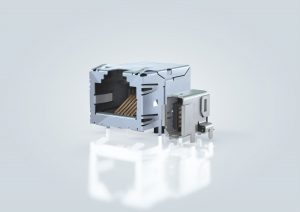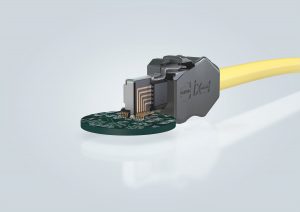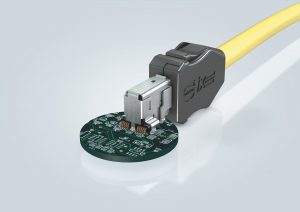
In search of the (much smaller) RJ45 successor
By Piotr Polak is DC2 product manager, industrial communications connectivity solutions, Harting Inc. of North America
Electronics Interconnect connector connector Ethernet Ethernet RJ45 RJ45While the standard eight-contact RJ45 has plenty of run left – it’s a proven, cost-effective choice for many applications – it’s also butting up against practical limitations in plant and product design.

An RJ45 socket.
Since the advent of the digital age, the venerable RJ45 has been the go-to choice for plant and device designers. Consumers simply know it as the ‘Ethernet jack’ that networks their computer, modem, printer and other devices. In industry, convenience and compatibility prevailed over other considerations for IP20 connectivity, so component makers complied; my company, for example, developed the RJ Industrial, which at the time was the world’s first industrial-grade RJ45, and more recently, the RJ Industrial 10G.
While the standard eight-contact RJ45 has plenty of run left – it’s a proven, cost-effective choice for many applications – it’s also butting up against practical limitations in plant and product design. It’s not particularly robust, prone to broken locking tabs and occasional contact and interference problems. More importantly, it’s unshrinkable. System planners and device designers urgently require smaller, more reliable Ethernet connectors to reduce the size of their devices or deploy hundreds of sensors to create a digital neural factory net on the shop floor. An RJ45 socket can take up most of the space in the housing on small industrial computers, switches, WLAN access points, routers, etc.
A miniaturized alternative to RJ45s should deliver 1/10 Gbit/s speeds, be extremely robust, deliver power and data with impeccable signal quality in the most challenging environments – like those in manufacturing, transportation, health science and vision and surveillance – and offer easy integration into existing IP20 networks. They should be designed and manufactured to a global standard. Round M8/M12 connectors tick some of these boxes, but they’re still too big for many applications.

HARTING ix Industrial – Ethernet Interface
That need for a tiny alternative prompted Harting and Hirose Electric of Japan to collaborate in developing a true miniature RJ45 successor, the 10-contact, rectangular ix Industrial. It’s 70% smaller than the RJ45, rated for Category 6A, with a high-current capacity (50Vac / 60Vdc at 1.5A) for current and future PoE/PoE+ and 4PPoE applications and an operating temperature rating of -40C to +85C. Developers were cognizant of the vulnerability associated with the RJ45 design, therefore, the ix Industrial has been designed to be considerably more robust. The connectors have a stable locking mechanism using two metal hooks, which engage with a clearly audible click when mated, providing the user with acoustic and haptic feedback.
Vibration-proof mechanism makes the connector suitable for any job
Such a safe, vibration-proof mechanism makes the connector suitable for any job with high mechanical loading. In order to compensate for forces exerted on the connector cable, the ix Industrial has excellent strain relief that connects firmly to the shielding via a robust shield crimp. This ensures a strong connection – from the five THR shield contacts connected by means of the two snap hooks in the plug area through to the cable itself. This rugged interface meets even the severe shock and vibration resistance required by the EN 50155 railway specifications, guaranteeing a long service life for at least 5,000 mating cycles. Even after this high number of (dis-)connections, all relevant parameters, such as transition and insulation resistance, voltage resistance and the connection and pulling forces, remain within the allowable limits.
The Harting test regime employed for ix Industrial connectors covers all environmental simulations such as various storage situations at climatic extremes and corrosive gases as well as a variety of mechanical tests to confirm vibration resistance, contact durability and connection and pulling forces. 
EMC is always a concern in high speed data transmission. The ix Industrial boasts 360º shielding. There are no unprotected wires from the cable to the connection point that could prevent a fault-free high frequency signal. The cable shield is crimped directly to the connector housing with the crimped ring for strain relief and continuous shield transition. In such a small connector with such small, closely arrayed contacts, it was a challenge to effectively minimize the interrelation between the individual data pairs. This was achieved by concealing a shield case between the two contact rows in the socket, which effectively prevents interrelation between the two opposing rows of five contacts each. In each row, the middle contact serves as a shield between two pairs of wires. This central contact on the pcb is connected to the earth potential. This contact arrangement is similar to that of the larger X-coded M12. Each pair of wires are well-shielded from their neighbours in a separate cable or connector quadrant, protecting against crosstalk.
Combining data transmission and power supply in a single interface
The connector’s Cat. 6A rating means the ix Industrial is future-proofed for 1/10 Gbit/s Ethernet. Combining data transmission and power supply in a single interface also reduces the installation space required for termination technology.
Easy network and production integration is assured by two factors. For on-board applications, the data contacts are SMD contacts; the connector’s pcb sockets can be processed using normal reflow soldering along with all other conventional components. No separate manual or wave-soldering step is necessary; the connector interface is firmly anchored on the board and can withstand rough handling. Its miniaturized socket and plugs allow a significantly higher packing density, so designers can reduce the size of their end devices. With the upright and angled ix Industrial sockets now on the market, the minimum spacing between sockets is just 10 mm. A flat, angled design is under development for very flat devices. Angled variants will make possible more space critical applications using angled cable outlets.
For cabling, the ix Industrial can be assembled with the mating face on both ends or mixed, i.e. with it on one end and either an RJ45 or M12 on the other. This enables a gradual adoption of this new technology in controls architecture without the need to directly revise entire systems. The development of the ix Industrial mating face was designed and built to its own certification standard – IEC 61076-3-124 – to provide users with quality assurance and investment security. Harting is orienting development towards the industrial market, while HIROSE is offering miniaturized connection solutions for small portable devices such as mobile phones, tablets and cameras.
“Industry 4.0 as an expression of the Internet of Things needs one thing above all – an Ethernet connection to any Industry 4.0 component,” says Philip Harting, chairman of the Harting Technology Group. “The international standardization of new high performance components and infrastructures is an essential prerequisite for market success and provides security in terms of planning.”
